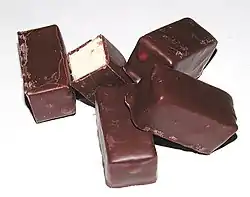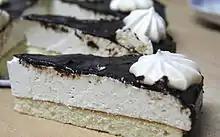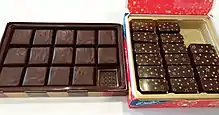Ptasie mleczko
Ptasie mleczko (Polish: [ptaɕɛ mlɛtʂkɔ] (![]() listen)) is a soft chocolate-covered candy filled with soft meringue or milk soufflé.[1] It is called ptichye moloko (птичье молоко, [ˈptʲitɕjɪ məlɐˈko]) in Russian, lapte de pasăre ([ˈlapte de ˈpasəre]) in Romanian, ptashyne moloko (пташине молоко) in Ukrainian, and linnupiim in Estonian. All these names literally mean "bird's milk" or crop milk, a substance somewhat resembling milk, produced by certain birds to feed their young. However, this is not the origin of the name; rather, "bird's milk" is an idiom of ancient Greek origin meaning "an unobtainable delicacy" (compare English: "hen's teeth").[2]
listen)) is a soft chocolate-covered candy filled with soft meringue or milk soufflé.[1] It is called ptichye moloko (птичье молоко, [ˈptʲitɕjɪ məlɐˈko]) in Russian, lapte de pasăre ([ˈlapte de ˈpasəre]) in Romanian, ptashyne moloko (пташине молоко) in Ukrainian, and linnupiim in Estonian. All these names literally mean "bird's milk" or crop milk, a substance somewhat resembling milk, produced by certain birds to feed their young. However, this is not the origin of the name; rather, "bird's milk" is an idiom of ancient Greek origin meaning "an unobtainable delicacy" (compare English: "hen's teeth").[2]
 Confectionery | |
| Alternative names | ptichye moloko, lapte de pasăre, ptashyne moloko, linnupiim, Vogelmilch |
|---|---|
| Place of origin | Poland (confectionery), Russia (cake) |
| Main ingredients | Sugar, chocolate, powdered milk |
It is one of the most recognized chocolate confectionery in Poland having exclusive rights for the name. Other confectionery producers also make similar candies but named differently (e.g. Alpejskie mleczko, "Alpine milk"). Nonetheless, Ptasie mleczko is often used to refer similar candies with vanilla, cream, lemon or chocolate taste.
In Russia ptichye moloko is both a popular candy and a famous soufflé cake. The brand was introduced in the Soviet times and is nowadays used by the companies operating the factories which produced these candies and cakes since that time. The candies are also produced in other post-Soviet states, in particular in Belarus, Ukraine, Moldova and Estonia.
Origin of the name
The concept of avian milk (Ancient Greek: ὀρνίθων γάλα, ornithon gala) stretches back to ancient Greece. Aristophanes uses "the milk of the birds" in the plays The Birds[3] and The Wasps[4] as a proverbial rarity. The expression is also found in Strabo's Geographica where the island of Samos is described as a blest country to which those who praise it do not hesitate to apply the proverb that "it produces even bird's milk" (φέρει καί ὀρνίθων γάλα).[2][5] A similar expression lac gallinaceum (Latin for "chicken's milk") was also later used by Petronius (38.1) and Pliny the Elder (Plin. Nat. pr. 24) as a term for a great rarity. The idiom became later common in many languages and appeared in Slavic folk tales.[6][7][8] In one such tale the beautiful princess tests the ardor and resourcefulness of her suitor by sending him out into the wilderness to find and bring back the one fantastical luxury she does not have: bird's milk.[8] In the fairy tale Little Hare by Aleksey Remizov (who wrote many imitations of traditional Slavic folk tales) the magic bird Gagana produces milk.[9]
History and variations
In Poland, Jan Wedel, owner of the E. Wedel Company, developed the first ptasie mleczko in 1936.[10] According to the company's official history, Wedel's inspiration for the name of the confectionery came from his voyages to France, when he asked himself: "What could bring greater happiness to a man who already has everything?" Then he thought: "Maybe only bird milk."[11]
In Russia, ptichye moloko was originally a type of candy introduced in 1967 in Vladivostok and in 1968 by the Rot Front factory in Moscow. It became a hit, and mass production was started in 1975 by the Krasny Oktyabr ("Red October") confectionery factory in Moscow.[8][12]

In 1978, the popular candy was transformed into a cake by Vladimir Guralnik in Moscow's Praga Restaurant.[8] This was a light sponge cake filled with an airy soufflé and topped with chocolate glaze. A distinct feature of the Russian recipe is the usage of agar-agar instead of gelatin as a thickening agent which withstands the high temperature needed to reach the optimum soufflé consistency.[13][14] The recipe was quickly copied by other restaurants in Moscow, such as Moskva, Budapesht, and Ukraina.[12] In the 1980s, a special factory for ptichye moloko cakes was built in the Novye Cheryomushky district in the south of Moscow.[12] Both the cake and the candy versions of ptichye moloko are widely available to this date in supermarkets and specialty stores all over Russia.
In Estonia, linnupiim (also "bird's milk" in Estonian) is the brand name of a similar candy made by the Kalev candy factory.[15] This candy also uses agar-agar instead of gelatin as a thickening agent and comes in three flavors: chocolate, vanilla, and lemon.
In Moldova, lapte de pasăre (also "bird's milk" in Romanian) is the brand name of a similar candy made by the Bucuria candy factory.[16] Despite the name, the candy is not to be confused with the Romanian traditional dessert lapte de pasăre.
Trade marks
The phrases Lapte de pasăre, Ptasie Mleczko, Ptiche moloko, and Vogelmilch are registered trademarks in the EU.[17]
In Russia, Птичье молоко is a registered trademark of Rot Front, a member of United Confectioners. Other companies have been sued for using the name, even if they used it during the Soviet times.[18][19][20][21]
References
- Candy That's Dandy. Rick Kogan. Chicago Tribune. MAGAZINE; ZONE: C; SIDEWALKS.; Pg. 6. February 11, 2001.
- Daniela Dueck. Bird’s Milk in Samos: Strabo’s Use of Geographical Proverbs and Proverbial expressions. Scripta Classica Israelica, 23 (2004) 41-56.
- Aristophanes. The Birds, 1670. Pisthetaerus, a citizen of Athens, tells to Heracles: Do you want to fight? Why, be on my side, I will make you a king and will feed you on bird's milk and honey.
- Aristophanes. The Wasps, 508. Translated in English as "the most exquisite dishes". Greek original: 508.
- Strabo. Geographica. 14 - 1 - 15. Original text: Γεωγραφικά, ΙΔ.
- Птичье молоко. Фразеологизмы. Справочная служба русского языка Белгородской государственной универсальной научной библиотеки (in Russian).
- Александр Афанасьев. Народные русские сказки. 1855—1863. Заклятый царевич. (Alexander Afanasyev. Russian Fairy Tales. 1855—1863, in Russian)
- Berdy, Michele A. (February 1, 2007). "Ptichye Moloko". The Moscow Times.
- Aleksey Remizov. Posolon (1909). Complete Works. Russkaya kniga, Russian Academy of Sciences, 2000-2002, vol. 2, p. 75 (in Russian)
- Dear Valentine. The Warsaw Voice. January 31, 2007. A2007021256-13D17-GNW.
- "Ptasie mleczko" (PDF). Ftpsuperbrands.home.pl. Retrieved 15 December 2017.
- Mitlyng, Viktoria (May 22, 1997). "Cake Weighs Heavily in Russian Life". The Moscow Times.
- A Russian Fairy Tale Cake: Story and recipe on Russia Beyond the Headlines, 25 October 2007.
- Люди смотрят на меня, как на космонавта! Archived 2015-01-11 at the Wayback Machine, Вечерняя Москва, 29 сентября 2006 (An interview with Vladimir Guralnik. Vechernyaya Moskva, 29 September 2006, in Russian).
- "Kalev - Eesti suurim ja vanim kondiitritööstusettevõte". Kalev. Retrieved 15 December 2017.
- Candies with whipped egg-white mass. Bucuria J.S.C.
- "TMview". The European Union Intellectual Property Office.
- "Выемка документов идет в "Приморском кондитере" по заявлению столичных компаний" (in Russian). PrimaMedia. 11 Nov 2013.
- "Птичье молоко". Товарные знаки, знаки обслуживания и наименования мест происхождения товаров. Российское агенство по патентам и товарным знакам. Retrieved 15 December 2018.
- "О товарных знаках ОАО "Рот Фронт" (с изменениями на 17 ноября 2011 года), Письмо ФТС России от 26 ноября 2004 года №07-58/8672". Docs.cntd.ru. Retrieved 15 December 2017.
- https://primamedia.ru/news/295446/
External links
- E. Wedel chocolates
- Restaurant "Praga" in Moscow (in Russian)
- ООО «Птичье молоко». Moscow "Ptichye moloko" cake factory (in Russian)
- Bucuria, Chișinău
- Iconic Polish Sweets

%252C_SP-LDF%252C_Embraer_ERJ-170STD_(32564212741).jpg.webp)
